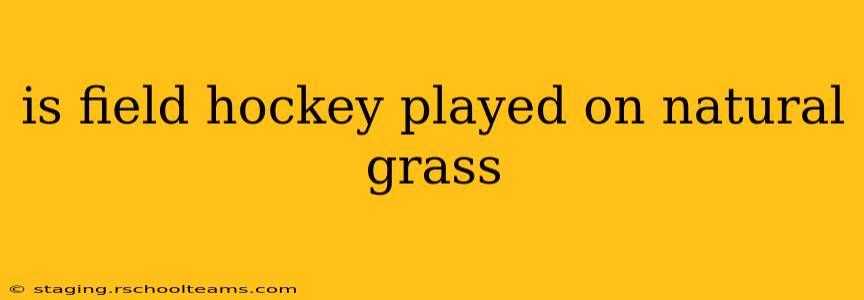Field hockey, a fast-paced and skillful sport, has a rich history intertwined with its traditional playing surface: natural grass. While artificial turf has become increasingly prevalent, the answer to whether field hockey is played on natural grass is a nuanced one. The short answer is: yes, but not exclusively.
Let's delve deeper into the complexities of field hockey's playing surfaces.
What is the Traditional Surface for Field Hockey?
Historically and traditionally, field hockey has been played on natural grass. This is where the game originated and flourished for centuries, shaping its tactics and techniques. The natural undulations and varying grass lengths added an element of unpredictability that demanded superior ball control and strategic play. Many enthusiasts still consider natural grass the truest and most enjoyable surface to play on. The feel of the ball on grass, the slight irregularities of the surface, and the connection to the sport's heritage all contribute to this sentiment.
Why is Artificial Turf Used in Field Hockey?
The rise of artificial turf (often referred to as AstroTurf) in field hockey is primarily due to practical considerations:
- Consistency and Playability: Artificial turf offers a consistent playing surface, unaffected by weather conditions like rain, snow, or extreme heat. Games can be played regardless of weather, ensuring a more reliable schedule.
- Maintenance: Natural grass fields require significant maintenance, including mowing, watering, fertilizing, and pest control. Artificial turf significantly reduces these maintenance requirements and costs.
- Availability: Artificial turf fields are often more readily available, particularly in areas with limited space or challenging climates for natural grass growth.
- Increased Speed of Play: Some believe artificial turf leads to a faster game, although this is a matter of some debate among players and coaches.
Is Natural Grass Still Used?
While artificial turf has become dominant, especially at higher levels of competition, natural grass remains a significant playing surface for field hockey. Many clubs and schools still utilize natural grass pitches, and some international tournaments and matches are played on them, particularly at more traditional venues. The choice of surface often depends on budget, location, and the specific preferences of the governing bodies or organizing committees.
What are the Advantages of Playing on Natural Grass?
Despite the prevalence of artificial turf, natural grass offers distinct advantages:
- Natural Feel: Many players and coaches prefer the "feel" of the ball on natural grass. It offers a slightly softer, more natural interaction compared to the harder artificial surface.
- Environmental Friendliness: Natural grass fields contribute positively to the environment, providing green spaces and absorbing carbon dioxide.
- Injury Prevention (Debated): While both surfaces have injury risks, some research suggests that natural grass may have a slightly lower risk of certain types of injuries. However, this is an area of ongoing research and debate.
What are the Disadvantages of Playing on Natural Grass?
The primary disadvantages of natural grass are its high maintenance needs and its susceptibility to weather conditions:
- Maintenance Costs: As mentioned, maintaining natural grass fields is expensive and requires specialized labor.
- Weather Dependent: Play can be disrupted or cancelled by rain, frost, or extreme heat, leading to scheduling difficulties.
- Inconsistency: The playing surface may be inconsistent due to uneven wear and tear, patches of bare earth, or different grass lengths.
What is the Future of Field Hockey Surfaces?
The future likely involves a continued use of both natural grass and artificial turf. The choice will depend on the specific needs and resources available. There’s also ongoing innovation in artificial turf technology, with advancements aiming to improve its characteristics and potentially better mimic the feel of natural grass.
In conclusion, while artificial turf has significantly increased its presence in field hockey, natural grass remains a valid and, for many, preferred playing surface. The choice depends on various factors, and both surfaces continue to play a role in the exciting world of field hockey.
